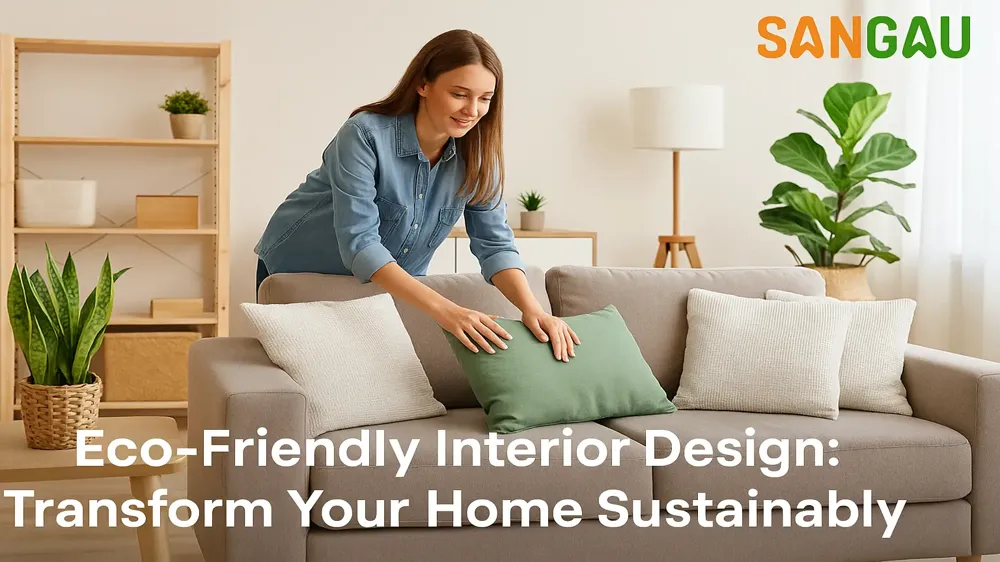Eco-Friendly Interior Design - Transform Your Home Sustainably
Published : 24 Jun 2025

Eco-Friendly Interior Design: Transform Your Home Sustainably
Hello everyone!
In today's world, sustainability is taking centre stage in every aspect of our lives. Transforming your living space into an eco-conscious haven is a powerful way to contribute to environmental preservation. By focusing on sustainable materials, energy efficiency, and creative recycling, you can craft interiors that are not only environmentally responsible but also visually captivating and uniquely yours. Let's explore practical and stylish ways to embrace sustainability in your home, designing spaces that align with your values and positively impact our planet.
1. Sustainable Materials: Creating with Eco-Conscious Choices
When embarking on eco-friendly interior design, the first step is selecting sustainable materials. Opt for renewable resources like bamboo, reclaimed wood, and natural fibres for furniture and decor. Bamboo is an excellent choice, thanks to its rapid growth and regeneration, making it an incredibly eco-friendly material. Natural fibres such as cotton, jute, and hemp are perfect for rugs, curtains, and upholstery, offering a biodegradable and less chemically intensive alternative to synthetics. Support eco-conscious brands or take on DIY projects to repurpose sustainable materials, adding a personal touch to your interiors. These choices not only minimise your environmental impact but also infuse your home with a warm, organic aesthetic.
2. Energy-Efficient Lighting: Brightening Your Home Sustainably
Lighting plays a crucial role in interior design, but it doesn’t have to come at an environmental cost. Switch to energy-efficient LED bulbs, which consume less energy and last longer than traditional lighting options. To further reduce energy usage, make the most of natural light by positioning furniture to let sunlight flow freely into your space. Mirrors can amplify natural light, enhancing brightness and creating a sense of openness. By embracing energy-efficient lighting, you lower energy consumption while crafting a well-lit, inviting atmosphere.
3. Indoor Plants: Enhancing Aesthetics and Air Quality
Indoor plants are a cornerstone of eco-friendly interiors, offering beauty and functionality. They not only elevate your decor but also improve air quality by absorbing toxins and releasing oxygen. Low-maintenance plants like snake plants, pothos, and spider plants are ideal for beginners or busy individuals. For a dramatic effect, larger plants such as fiddle leaf figs or rubber plants can serve as stunning focal points. Incorporating greenery into your home introduces a natural element that complements sustainable interiors without relying on synthetic materials.
4. Recycling and Upcycling: Adding Character Through Creativity
Recycling and upcycling breathe new life into old items, reducing waste and fostering creativity. Consider purchasing furniture and decor made from recycled materials, or repurpose existing items to suit your space. Upcycling is a fantastic way to craft unique pieces that reflect your personality. For instance, transform an old ladder into a chic bookshelf or convert wooden pallets into functional coffee tables. These projects not only reduce landfill waste but also add a layer of individuality to your home, showcasing your commitment to sustainable living.
5. Reducing Waste: Thoughtful Decor Choices for Sustainability
Minimising waste is a cornerstone of eco-friendly design. Replace single-use items with durable, sustainable alternatives. For example, opt for wooden frames instead of plastic for your artwork or photos, and choose reusable glass or metal over disposable plastics. Handmade decor items like woven baskets and ceramic pieces lend a natural, artisanal touch to your interiors while supporting sustainability. Thoughtful decor choices help create an environment that is both elegant and environmentally conscious.
6. Eco-Friendly Paints: Healthier Walls and Planet
Traditional paints can emit harmful chemicals into the air, but eco-friendly alternatives like low-VOC or non-toxic paints provide a safer option. These paints maintain air quality while offering an array of colours and finishes to suit your style. Refreshing your walls with eco-conscious paints not only protects your health but also aligns with a broader commitment to sustainability.
7. Eco-Conscious Flooring: Sustainable Underfoot Solutions
Flooring options like bamboo, cork, and reclaimed wood are excellent for sustainable interiors. Bamboo stands out for its durability and rapid regrowth, while cork’s unique texture and sustainable harvesting make it an appealing choice. Reclaimed wood adds rustic charm, preserving natural resources and reducing the need for new materials. By choosing eco-friendly flooring, you enhance your home’s visual appeal while staying true to your green goals.
8. Water-Efficient Fixtures: Conserving Resources with Style
Water conservation is a key component of eco-friendly design. Install water-efficient fixtures such as low-flow faucets, showerheads, and toilets to significantly reduce water usage. These fixtures combine practicality with sustainability, helping conserve precious resources while lowering utility bills. A green home is one that values every drop, making water-efficient fixtures an essential addition.
9. Eco-Friendly Cleaning Products: A Greener Approach to Maintenance
Sustaining an eco-friendly home requires green cleaning practices. Many commercial cleaners contain harmful chemicals, but eco-friendly alternatives are both safer and effective. Create your own solutions using natural ingredients like vinegar, baking soda, and essential oils. These DIY cleaners are not only cost-effective but also support a healthier indoor environment. By adopting eco-friendly cleaning methods, you maintain the sustainability of your home on every level.
10. Mindful Consumption: Choosing Quality Over Quantity
A mindful approach to consumption ensures a lasting commitment to sustainability. Invest in high-quality, durable furniture and decor that withstand the test of time. This reduces waste and encourages intentional purchasing decisions. Curating a home with long-lasting, meaningful items aligns with a lifestyle that values quality over quantity, embodying the principles of eco-friendly living.
Elevate Sustainability with Professional Services
Your journey toward an eco-friendly home doesn’t have to stop with interior design. SANGAU offers property management services designed to support sustainable living. From eco-conscious maintenance practices to green upgrades, SANGAU helps you create a space that reflects your commitment to the environment.
Hashtags:
#EcoFriendlyDesign #SustainableLiving #GreenHome #InteriorDesign #SANGAU


